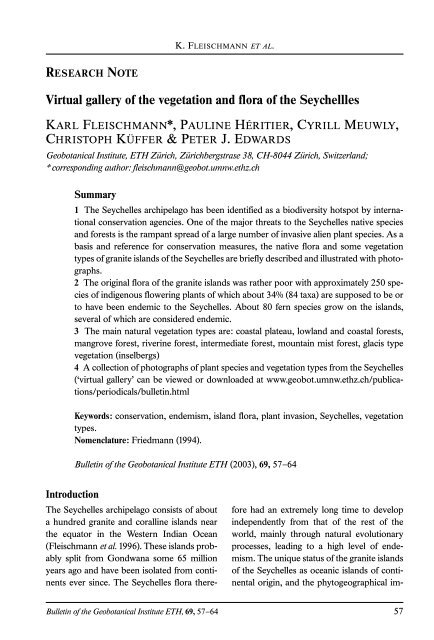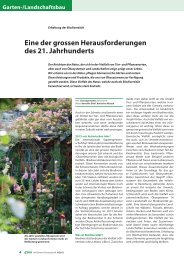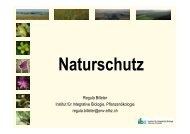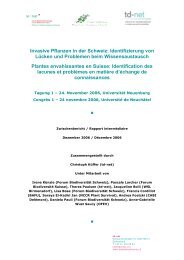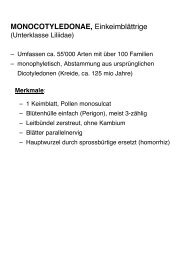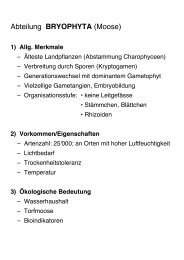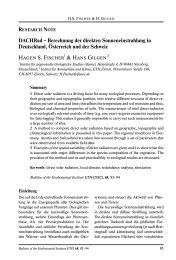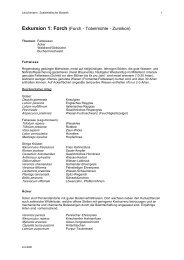PDF, 72 kB - Geobotanical Institute ETH Zurich - ETH Zürich
PDF, 72 kB - Geobotanical Institute ETH Zurich - ETH Zürich
PDF, 72 kB - Geobotanical Institute ETH Zurich - ETH Zürich
Create successful ePaper yourself
Turn your PDF publications into a flip-book with our unique Google optimized e-Paper software.
K. FLEISCHMANN ET AL.<br />
RESEARCH NOTE<br />
Virtual gallery of the vegetation and flora of the Seychellles<br />
KARL FLEISCHMANN*, PAULINE HÉRITIER, CYRILL MEUWLY,<br />
CHRISTOPH KÜFFER & PETER J. EDWARDS<br />
<strong>Geobotanical</strong> <strong>Institute</strong>, <strong>ETH</strong> <strong>Zürich</strong>, <strong>Zürich</strong>bergstrase 38, CH-8044 <strong>Zürich</strong>, Switzerland;<br />
* corresponding author: fleischmann@geobot.umnw.ethz.ch<br />
Summary<br />
1 The Seychelles archipelago has been identified as a biodiversity hotspot by international<br />
conservation agencies. One of the major threats to the Seychelles native species<br />
and forests is the rampant spread of a large number of invasive alien plant species. As a<br />
basis and reference for conservation measures, the native flora and some vegetation<br />
types of granite islands of the Seychelles are briefly described and illustrated with photographs.<br />
2 The original flora of the granite islands was rather poor with approximately 250 species<br />
of indigenous flowering plants of which about 34% (84 taxa) are supposed to be or<br />
to have been endemic to the Seychelles. About 80 fern species grow on the islands,<br />
several of which are considered endemic.<br />
3 The main natural vegetation types are: coastal plateau, lowland and coastal forests,<br />
mangrove forest, riverine forest, intermediate forest, mountain mist forest, glacis type<br />
vegetation (inselbergs)<br />
4 A collection of photographs of plant species and vegetation types from the Seychelles<br />
(‘virtual gallery’ can be viewed or downloaded at www.geobot.umnw.ethz.ch/publications/periodicals/bulletin.html<br />
Keywords: conservation, endemism, island flora, plant invasion, Seychelles, vegetation<br />
types.<br />
Nomenclature: Friedmann (1994).<br />
Bulletin of the <strong>Geobotanical</strong> <strong>Institute</strong> <strong>ETH</strong> (2003), 69, 57–64<br />
Introduction<br />
The Seychelles archipelago consists of about<br />
a hundred granite and coralline islands near<br />
the equator in the Western Indian Ocean<br />
(Fleischmann et al. 1996). These islands probably<br />
split from Gondwana some 65 million<br />
years ago and have been isolated from continents<br />
ever since. The Seychelles flora there-<br />
fore had an extremely long time to develop<br />
independently from that of the rest of the<br />
world, mainly through natural evolutionary<br />
processes, leading to a high level of endemism.<br />
The unique status of the granite islands<br />
of the Seychelles as oceanic islands of continental<br />
origin, and the phytogeographical im-<br />
Bulletin of the <strong>Geobotanical</strong> <strong>Institute</strong> <strong>ETH</strong>, 69, 57–64 57
VIRTUAL GALLERY OF THE VEGETATION AND FLORA OF THE SEYCHELLLES<br />
portance of the islands as combining African,<br />
Madagascan and Indo-Malaysian elements in<br />
their flora make it a region of great floristic<br />
interest. The fact that at the time of the first<br />
human settlement on Mahé in the 1770’s the<br />
flora had evolved continuously and without<br />
human interaction for many millions of years,<br />
certainly adds to the outstanding status of the<br />
Seychelles’ island vegetation. In fact the Seychelles<br />
have been identified as a biodiversity<br />
hotspot by Conservation International and as<br />
a centre of plant diversity by the WWF and<br />
IUCN.<br />
One of the major threats to the native species<br />
and forests of the Seychelles is the rampant<br />
spread of a number of alien plant species<br />
across the islands (Fleischmann 1997);<br />
the most invasive ones are Cinnamomum<br />
verum, Psidium cattleianum, Clidemia hirta,<br />
Merremia peltata and Paraserianthes falcataria.<br />
These plants displace the distinctive<br />
native flora of the Seychelles, resulting in the<br />
loss of diverse native forests. The situation in<br />
the Seychelles is particularly serious because<br />
there are several rare, endemic species like<br />
Medusagyne oppositifolia, Secamone schimperiana,<br />
Vateriopsis seychellarum etc. which are<br />
fated to extinction following the invasion of a<br />
great variety of introduced organisms. It is<br />
generally accepted that invasive alien species<br />
may have a competitive or reproductive advantage<br />
over native species (Parendes 2000).<br />
Besides this, the introduction of certain plant<br />
species may promote further change because<br />
they affect ecosystem processes. Invasive<br />
species can influence nitrogen availability<br />
by changing litter quantity and quality,<br />
rates of N 2 -fixation, or rates of nitrogen loss<br />
(Evans et al. 2001; Anderegg & Wiederkehr<br />
2001). A variety of biological attributes of<br />
plants serve to make them invasive, but in<br />
the Seychelles three are of primary importance.<br />
• Propagules dispersed by animals. Animaldispersed<br />
seeds are typically fleshy berries,<br />
relatively small in size, and variously colored.<br />
The dispersers of greatest importance<br />
in the Seychelles are fruit-eating birds and<br />
bats. Prominent amongst introduced species<br />
with bird-dispersed fruits are Cinnamomum<br />
verum, Psidium cattleianum and Clidemia<br />
hirta. Species using animals or wind as<br />
dispersal mechanisms (i.e. Paraserianthes f.)<br />
are capable of quickly invading native ecosystems<br />
in areas remote from where the<br />
adults themselves are planted. As for Cinnamomum<br />
v. and Psidium c. an additional<br />
attribute making these plants even worse is<br />
that they can reproduce vegetatively as well<br />
as by seeds.<br />
• High fecundity. Species that produce many<br />
seeds per plant each year can invade new<br />
habitat patches more rapidly than can most<br />
native plants that produce relatively few<br />
seeds (Peters 2001). For example, Cinnamomum<br />
v. and Clidemia h. (the latter is now<br />
the subject of a control effort by state and<br />
private organizations) produce large numbers<br />
of seeds, so that their populations can<br />
increase very rapidly, which partially accounts<br />
for the great threat they pose to the<br />
Seychelles’ forests.<br />
• Fast growth: Fast-growing plants that<br />
quickly reach maturity will be more invasive<br />
and harder to control than slowergrowing<br />
plants. An outstanding example<br />
of the importance of this phenomenon is<br />
Clidemia h. which was first seen on Mahé<br />
island in 1993 (Gerlach 1993). Since then<br />
single plants have been found all over the<br />
island. By competing with native species<br />
in gaps, Clidemia h. invasion has the potential<br />
to alter forest regeneration (Peters<br />
2001).<br />
In order to prevent fundamental changes to<br />
the indigenous and endemic vegetation of the<br />
58 Bulletin of the <strong>Geobotanical</strong> <strong>Institute</strong> <strong>ETH</strong>, 69, 57–64
K. FLEISCHMANN ET AL.<br />
Seychelles an ongoing commitment to controlling<br />
invasive alien species is required. This<br />
commitment is based on scientific research<br />
which provides a wider perspective on the<br />
problem of invasion by alien species, and a<br />
rational basis for habitat management (i.e. the<br />
control of this invasion). It has become obvious<br />
that the protection of land in itself will not<br />
be sufficient to save the habitats. Since most<br />
areas of the Seychelles are heavily infested<br />
with alien plants, the crucial question is: what<br />
can be done to save the remaining, intact native<br />
forests? To address this question, several<br />
research projects in the field of conservation<br />
and invasion biology have been conducted<br />
through the <strong>Geobotanical</strong> <strong>Institute</strong> in <strong>Zürich</strong><br />
over the last eleven years.<br />
Despite the wide scale destruction of the<br />
original island vegetation, there are sites<br />
where at least some of the original elements of<br />
the natural flora have been preserved. On<br />
Mahé and Silhouette there are still substantial<br />
areas of humid high-altitude forests and<br />
inselbergs containing a rich endemic flora.<br />
Luckily, relatively few of the endemic plant<br />
species are so far known to have become extinct<br />
on all islands (Carlstroem 1996). However,<br />
the fact that populations of many endemic<br />
and threatened species are extremely<br />
small is a serious concern. For many of these<br />
species, especially those of the ancient forests<br />
at intermediate altitude, the situation is critical<br />
since their natural habitats no longer exist.<br />
These species (e.g. Medusagyne oppositifolia)<br />
will never survive without human interference.<br />
It is most likely that the displacement of<br />
the native flora through competition with invasive<br />
exotic taxa will reduce biodiversity<br />
through the altering of the physical environment,<br />
increased erosion and perhaps the disruptive<br />
effects on nutrient recycling.<br />
Given the critical status of the last remnants<br />
of native Seychelles vegetation, it is essential<br />
to carefully describe and document their<br />
present condition as a reference for future<br />
conservation measures. The purpose of this<br />
article is (a) to give a brief account of the historic<br />
development of the Seychelles flora and<br />
(b) to describe its main vegetation types with<br />
characteristic plant species. This description<br />
is illustrated by photographs available in electronic<br />
form. A similar account was given by<br />
Francis Friedmann (1987) in his book “Flowers<br />
and Trees of the Seychelles”. This book<br />
comprises a selection of remarkable pictures<br />
of the Seychelles flora on the granite islands,<br />
including typical habitats and beautiful scenes.<br />
Unfortunately, this work is now out of<br />
print and cannot be re-printed in the original<br />
form because many of the original pictures<br />
were destroyed by fire. Therefore, this contribution<br />
and the associated “virtual gallery”<br />
with photographs of prominent plants and<br />
typical vegetation types is intended to be a<br />
small substitute of what is no longer available.<br />
The Seychelles flora and its history<br />
Thanks to a large number of contributors and<br />
the rather restricted area of the land, the flora<br />
of the Seychelles is at present rather well<br />
known and we have a fairly good knowledge<br />
of the conservation status of most species.<br />
The original flora of the granite islands was<br />
rather poor with approximately 250 species<br />
of indigenous flowering plants of which about<br />
34% (84 taxa) are supposed to have been endemic.<br />
There are also about 80 fern species<br />
growing on the islands, several of which are<br />
supposed to be endemic to the Seychelles<br />
(Fleischmann 1997).<br />
While most oceanic islands have received<br />
their flora predominantly by long-distance<br />
(i.e. 1000 km) dispersal, the native flora of the<br />
Seychelles probably derived predominantly<br />
from ancestors which were already present<br />
Bulletin of the <strong>Geobotanical</strong> <strong>Institute</strong> <strong>ETH</strong>, 69, 57–64 59
VIRTUAL GALLERY OF THE VEGETATION AND FLORA OF THE SEYCHELLLES<br />
on the Seychelles microcontinent 65 million<br />
years ago when the archipelago was about to<br />
split up from Gondwanaland. Few species in<br />
the Seychelles have seeds that are adapted to<br />
long-distance dispersal. Before the arrival of<br />
humans, only a minor part of the native flora,<br />
mainly in the coastal zone and in the wetlands,<br />
had probably arrived by long-distance<br />
dispersal.<br />
As can be expected from the geological history<br />
of the area, the native flora of the Seychelles<br />
includes elements of African, Madagascan<br />
and Indo-Malaysian origin, with the<br />
latter being the most prominent (Cox & Moor<br />
1996). A considerable proportion of the endemic<br />
species are probably relict elements<br />
from an ancient widespread Gondwana-flora<br />
which became extinct on the mainlands but<br />
survived in the Seychelles. Many primitive<br />
characters have been preserved in relict species<br />
such as Medusagyne oppositifolia and<br />
Psathura seychellarum (Procter 1974).<br />
After the ice age a period of submergence<br />
followed when the Seychelles microcontinent<br />
was reduced from a more or less continuous<br />
land mass of 43’000 km 2 to scattered islands<br />
with a total area of about 245 km 2 (Stoddart<br />
1984). This dramatic reduction in land area<br />
undoubtedly must have been accompanied<br />
by massive extinctions in the flora. The species<br />
occurring in the lowlands would have<br />
been especially affected. This theory is supported<br />
by the fact that the main part of the<br />
endemic species are found at intermediate<br />
and high altitudes, whereas only two species<br />
are confined to the coastal zone.<br />
During the long period of isolation of the<br />
islands, evolution may have slowly given rise<br />
to new plant species like Lodoicea maldivica<br />
(Edwards et al. 2002). Groups of taxa which<br />
have probably evolved after the isolation of<br />
the Seychelles microcontinent exist within<br />
genera like Gastonia (three species and three<br />
varieties), and in the Hypoxidiaceae (Hypoxidia<br />
rhizophylla, Hypoxidia mahensis) (Carlstroem<br />
1996).<br />
The present flora of the Seychelles is relatively<br />
homogeneous (Carlstroem 1996). No<br />
differences in morphological characters were<br />
observed between populations on different island<br />
(Fleischmann, personal observation).<br />
However, it is still possible that genetic differentiation<br />
exists among the different island<br />
populations; this could be revealed by genetic<br />
analyses.<br />
Natural vegetation types on the granite<br />
islands<br />
Although a full documentation of the original<br />
vegetation types of Seychelles is lacking,<br />
some conclusions can be drawn from the<br />
present vegetation, in combination with old<br />
written records. The following vegetation<br />
types have been identified on the granite islands.<br />
COASTAL PLATEAU<br />
We only have very scarce reports on the composition<br />
of the shore vegetation from the earlier<br />
records, which mainly noted the more<br />
important timber trees. The exploitation of<br />
the trees of the beach crest as well as the construction<br />
of sea walls, land reclamation, construction<br />
of houses, coconut plantations, etc.<br />
have all contributed to the alteration of the<br />
original coastal vegetation. Our knowledge<br />
about the original composition is therefore<br />
limited (Sauer 1967).<br />
By the time the first settlers arrived on the<br />
Seychelles the shores were fringed with coconut<br />
palms which were believed to have grown<br />
from nuts cast up by the sea. Other trees mentioned<br />
from the shores in the earlier reports<br />
were Casuarina equisetifolia, Terminalia catappa,<br />
Calophyllum inophyllum, Cordia subcor-<br />
60 Bulletin of the <strong>Geobotanical</strong> <strong>Institute</strong> <strong>ETH</strong>, 69, 57–64
K. FLEISCHMANN ET AL.<br />
data. It has been much discussed whether<br />
Terminalia catappa, Casuarina equisetifolia and<br />
Cocos nucifera were brought to the Seychelles<br />
by the first people visiting the islands or<br />
whether they were present before the first arrival<br />
of humans. Certainly they were already<br />
widely spread by this time, and they now<br />
form an integral part of the coastal vegetation.<br />
The dominant shrub on the beach crests<br />
today is Scaevola sericea. Other common<br />
shore-line trees are Cocos nucifera, Calophyllum<br />
inophyllum, Hernandia nymphaeifolia,<br />
Hibiscus tiliaceus, Barringtonia asiatica,<br />
Guettarda speciosa and Cordia subcordata, in<br />
the past frequently mixed with Tournefortia<br />
argentea, Suriana maritima and Sophora tomentosa.<br />
Scramblers and creeping plants are<br />
common in the shore vegetation. Most species<br />
growing along the coast are species common<br />
to the shores of most tropical islands and<br />
the endemic flora has never played an important<br />
role on the littoral.<br />
LOWLAND AND COASTAL FORESTS<br />
The lowland forests originally covered the<br />
mountain sides up to about 200–300 m. The<br />
coastal plains were originally described as being<br />
covered by magnificent trees reaching up<br />
to 20–25 m, with a circumference of 4–5 m<br />
and with very straight trunks. The trees were<br />
spaced at 2.5–3.5 m from each other with<br />
hardly any branches for the first 15–20 m.<br />
Species like Terminalia catappa, Casuarina equisetifolia,<br />
Intsia bijuga, Calophyllum inophyllum,<br />
Heritiera littoralis, Mimusops seychellarum,<br />
Vateriopsis seychellarum, Syzygium wrightii and<br />
Cordia subcordata were described as common<br />
in this zone in the first records. Palm trees,<br />
especially Phoenicophorium borsigianum, Nephrosperma<br />
vanhoutteana and Deckenia nobilis<br />
were also mentioned from the original lowland<br />
forests, especially on dry ridges. The species<br />
composition of the woods of Silhouette<br />
was described as being the same but smaller.<br />
The islands of Cousin, Cousine and Aride<br />
were apparently never well wooded and were<br />
described as covered by scrubland even in the<br />
first records from Malavoise 1786–87 (Carlstroem<br />
1996).<br />
The primary lowland flora was apparently<br />
composed partly of endemic species as well<br />
as indigenous species more widely spread on<br />
most islands in the Indian Ocean; however, it<br />
is obvious that the endemic species played a<br />
less important role in the lowland vegetation<br />
than at the higher elevations.<br />
MANGROVE FOREST<br />
Near the sea level were also the mangrove<br />
swamps dominated by the same six species of<br />
mangrove trees that occur today, with Avicennia<br />
marina and Rhizophora mucronata being<br />
the most prominent at present. The exposed<br />
open sea coasts have never been colonised<br />
by mangroves. Hence the mangrove<br />
have always been found only on the more<br />
tranquil lagoon shores. The earliest settlers<br />
reported extensive areas covered with almost<br />
impenetrable mangroves, especially along the<br />
East coast of Mahé. All species known from<br />
the mangrove swamps have a wide distribution<br />
and no endemic species are known to<br />
occur in this vegetation type.<br />
RIVERINE FOREST<br />
The vegetation along most rivers in the Seychelles<br />
was much affected by human activities<br />
and there is little information on riverine forests<br />
to be found in the literature. Most of the<br />
remaining river forests are composed of palm<br />
trees, especially Phoenicophorium borsigianum,<br />
Verschaffeltia splendida, frequently associated<br />
with Barringtonia racemosa and Pandanus balfouri<br />
at the lower altitudes. Possibly Vateriopsis<br />
seychellarum also formed part of this community.<br />
There also seems to be a constant asso-<br />
Bulletin of the <strong>Geobotanical</strong> <strong>Institute</strong> <strong>ETH</strong>, 69, 57–64 61
VIRTUAL GALLERY OF THE VEGETATION AND FLORA OF THE SEYCHELLLES<br />
ciation of Pandanus hornei and Verschaffeltia<br />
splendida.<br />
INTERMEDIATE FOREST<br />
From 200 to 500 m there was an intermediate<br />
forest zone. These forests were rich in species<br />
and had a high canopy at least occasionally<br />
reaching up to 30–40 m. The big trees were<br />
spaced at approximately 9–10-m intervals,<br />
and the trunks were very straight. The forest<br />
at intermediate altitudes was the one richest<br />
in endemic species; endemics made up the<br />
main part of the vegetation. These forests<br />
have now been almost entirely cut down and<br />
most of the remaining areas have been heavily<br />
invaded by exotic species or have been<br />
planted with exotic forest trees. Areas with<br />
intermediate forests with at least remnants of<br />
the high canopy are now very rare in the Seychelles.<br />
Most of the remaining forests have<br />
been combed through for timber and most<br />
suitable tall trees have been cut down. It is<br />
therefore difficult to judge what the species<br />
composition in these forests was like and evidence<br />
of its former appearance can only be<br />
gained from much modified scattered<br />
patches. Our best knowledge of the vegetation<br />
from the intermediate altitudes comes<br />
from the exposed rocky areas and some river<br />
ravines which have served as sanctuaries for<br />
much of the flora.<br />
At drier sites the intermediate forests have<br />
probably been dominated by the endemic<br />
palm trees associated with Campnosperma<br />
seychellarum, Diospyros seychellarum, Memecylon<br />
eleagni, Excoecaria benthamiana, Paragenipa<br />
wrightii, Erythroxylon seychellarum,<br />
Syzygium wrightii, Canthium bibracteatum,<br />
Soulamea terminalioides, etc., whereas forests<br />
at more humid sites were dominated by<br />
Northea hornei, Dillenia ferruginea, Vateriopsis<br />
seychellarum, Grisollea thomassetii, Pouteria<br />
obovata, Campnosperma seychellarum, and Gastonia<br />
crassa (Bwa Bannann). Palms were of<br />
only minor importance in the forests of the<br />
more humid type. There were also large<br />
stands of screwpines (Pandanaceae). Tree<br />
ferns (Cyathea seychellarum) have been described<br />
as a common feature in the humid intermediate<br />
forests and along the river ravines.<br />
Much of the dry ridges with a shallow soil<br />
have been described as having a Mimusops /<br />
Excoecaria dominated forest type. This kind<br />
of vegetation is now only to be found as scattered<br />
remnants on rocky outcrops. The creeper<br />
Merremia peltata and the only recently established<br />
Clidemia hirta have started to heavily<br />
invade the lowland- and intermediate forests<br />
on Mahé.<br />
MOUNTAIN MIST FOREST<br />
High altitude forest originally covered most<br />
land above 400–500 m in the Seychelles. On<br />
mainland tropical mountains, mist forest is<br />
typically found at altitudes of between 2000<br />
and 3500 m, but on steep small islands like<br />
the Seychelles mist forests develop at much<br />
lower altitudes. The transition into the mist<br />
forest zone is gradual and depends greatly on<br />
local conditions. In many places the transition<br />
between the intermediate and high altitude<br />
forests have been obscured by the dominance<br />
of exotic vegetation, which grows from sea<br />
level to the highest elevations, making the<br />
transition less obvious. The conditions at the<br />
high altitudes are more humid and a mountain<br />
mist forest develops where the annual<br />
rainfall is well over 3000 cm yr -1 . These areas<br />
are often enshrouded in low clouds.<br />
Even these high altitude areas have suffered<br />
from heavy cutting of selected trees, so there<br />
are only a few relict stands of primeval forest<br />
left. The remaining areas, however, give us an<br />
idea of its former appearance. The remnants<br />
of high altitude forest are still dominated by<br />
native species, giving an idea of the original<br />
62 Bulletin of the <strong>Geobotanical</strong> <strong>Institute</strong> <strong>ETH</strong>, 69, 57–64
K. FLEISCHMANN ET AL.<br />
structure of this forest type. The mountain<br />
mist forest is rich in mosses, lichens, filmy<br />
ferns and epiphytic orchids. Tree ferns (Cyathea<br />
seychellarum) are a common feature of<br />
this forest type. Climbers like Schefflera<br />
procumbens were described as a characteristic<br />
feature in the past but are now much less<br />
common. The trees in the mist forest exhibit a<br />
reduced tree stature and increased stem density<br />
compared to forests of lower lying areas.<br />
As a result of the cutting of the best timber<br />
trees in the canopy, the second-story trees often<br />
form a new lower canopy today which is<br />
lower than the original. However, big trees<br />
can still be found at undisturbed sites at<br />
higher altitudes indicating that the canopy<br />
was previously up to about 15 m tall with a<br />
circumference of more than 2 m. Northea hornei<br />
was, and still is, the dominant species of<br />
the canopy of this zone. It commonly occurs<br />
with Pandanus seychellarum and with a second-story<br />
vegetation of Roscheria melanochaetes,<br />
Gastonia crassa, Psychiotria pervillei,<br />
etc. In the original forest at the higher altitudes<br />
endemic species dominated the vegetation.<br />
The total number of endemic species in<br />
the mist forest is, however, lower than at the<br />
intermediate altitudes.<br />
GLACIS TYPE VEGETATION (INSELBERGS)<br />
On the granite islands of the Seychelles there<br />
is a vegetation element which cannot be related<br />
to altitude. This vegetation type, comprising<br />
vegetation growing on solitary, often<br />
monolithic rocks or parts of mountain systems<br />
which rise abruptly from their surroundings,<br />
is locally called “glacis-type” vegetation.<br />
The term “glacis” is French and means<br />
“steep, rocky slope”. Glacis are freely exposed<br />
precambrian rock outcrops, which in<br />
geomorphological terms are known as inselbergs.<br />
On the Seychelles they occur throughout<br />
the above-mentioned habitats from the<br />
seashore to the mountain tops. Extreme<br />
edaphic and climatic conditions (high degree<br />
of insolation combined with high evaporation<br />
rates) exert an strong selective pressure resulting<br />
in a vegetation that is very different<br />
from the surroundings. Soil which accumulates<br />
in pockets and fissures of the rock consists<br />
largely of coarse quartz sand with variable<br />
amounts of peaty organic matter. If the<br />
peat cover is destroyed by clearing of the vegetation<br />
or fire the underlying bare rock is exposed.<br />
These factors have given rise to a vegetation<br />
type which is characterised by an outstanding<br />
degree of endemism, locally as high<br />
as 96%. Taxa typically growing on inselbergs<br />
are Pandanus multispicatus, Memecylon eleagni,<br />
Mimusops seychellarum, Excoecaria benthamiana,<br />
Soulamea terminalioides and on<br />
just a few locations the very rare Medusagyne<br />
oppositifolia.<br />
Virtual gallery<br />
A collection of photographs of typical vegetation<br />
types and their characteristic plant species<br />
is given under http://www.geobot.umnw.<br />
ethz.ch/publications/periodicals/bulletin.html<br />
(on this web page, select “Electronic Appendices”,<br />
and there “App. 2003-7”).<br />
This Appendix consists of a text part, which<br />
provides a concise compendium of the most<br />
important vegetation types, and a total of 74<br />
photographs, which can be accessed from the<br />
text through hyperlinks. Most plant species<br />
mentioned in the two preceding sections of<br />
this article are represented in the virtual gallery.<br />
The photographs can be viewed on the<br />
screen and downloaded as jpg files. They<br />
have been produced by Karl Fleischmann,<br />
Pauline Héritier and Cyrill Meuwly during<br />
field work in 2001–2002. They can be used<br />
freely for teaching and scientific purposes,<br />
provided that the full source is indicated.<br />
Bulletin of the <strong>Geobotanical</strong> <strong>Institute</strong> <strong>ETH</strong>, 69, 57–64 63
VIRTUAL GALLERY OF THE VEGETATION AND FLORA OF THE SEYCHELLLES<br />
It is the authors’ hope that a wider appreciation<br />
of the beauty and uniqueness of the Seychelles<br />
flora, as reflected by the photographs<br />
in the virtual gallery, will stimulate further<br />
research aimed at protecting these plants<br />
against increasing human disturbance and alien<br />
plant invasions.<br />
Acknowledgements<br />
Karsten Rohweder and Hans-Heini Vogel<br />
skilfully supported us in constructing the virtual<br />
gallery. We also thank Sabine Güsewell<br />
and an anonymous referee for helpful comments<br />
on the manuscript.<br />
References<br />
Anderegg, M. & Wiederkehr, F. (2001) Problems<br />
with Paraserianthes falcataria on Mahé, Seychelles.<br />
Master’s Thesis, <strong>Geobotanical</strong> <strong>Institute</strong><br />
<strong>ETH</strong>, <strong>Zürich</strong>.<br />
Carlstroem, A. (1996) Endemic and threatened plant<br />
species on the granite Seychelles. Report to the<br />
Ministry of Foreign Affairs, Division of Environment,<br />
Seychelles.<br />
Cox, C.B. & Moor, P.D. (1996) Biogegography, an<br />
ecological and evolutionary approach. Blackwell<br />
Science, Oxford.<br />
Edward, P.J., Kollmann, J. & Fleischmann, K.<br />
(2002) Life history evolution in Lodoicea maldivica.<br />
Nordic Journal of Botany, 22, 227–237.<br />
Evans, R.D., Rimer, R. & Sperry, L. (2001) Exotic<br />
plant invasions. Ecological Applications, 11, 1301–<br />
1310.<br />
Fleischmann, K., Porembski, S., Biedinger, N. &<br />
Barthlott, W. (1996) Inselbergs in the sea: Vegetation<br />
of granite outcrops on the islands of Mahé,<br />
Praslin and Silhouette (Seychelles). Bulletin of the<br />
<strong>Geobotanical</strong> <strong>Institute</strong> <strong>ETH</strong>, 62, 61–74.<br />
Fleischmann, K. (1997) Invasion of alien woody<br />
plants on the islands of Mahé and Silhouette,<br />
Seychelles. Journal of Vegetation Science, 8, 5–12.<br />
Friedmann, F. (1987) Flowers and trees of Seychelles.<br />
ORSTOM, Paris.<br />
Gerlach, J. (1993) Invasive Melastomataceae in<br />
Seychelles. Phelsuma, 1, 18–38.<br />
Peters, H.A. (2001) Clidemia hirta invasion at the<br />
Pasoh Forest Reserve: An unexpected plant invasion<br />
in an undisturbed tropical forest. Biotropica,<br />
33, 60–68.<br />
Parendes, L.A. & Jones, J.A. (2000) Role of light<br />
availability and dispersal in exotic plant invasion<br />
along roads and streams in the H. J. Andrews<br />
Experimental Forest, Oregon. Conservation Biology,<br />
14, 64–75.<br />
Procter, J. (1974) The endemic flowering plants of<br />
the Seychelles: an annotated list. Candollea, 29,<br />
345–387.<br />
Robertson, S.A. (1989) Flowering plants of Seychelles.<br />
Royal Botanic Gardens, Kew.<br />
Sauer, J.D. (1967) Plants and man on the Seychelles<br />
coast. A study in historical biogeography. The University<br />
of Wisconsin Press, Madison, London.<br />
Stoddart, D.R. (1984) Biogeography and Ecology of<br />
the Seychelles Islands. Monographiae Biologicae,<br />
Boston & Lancaster.<br />
Whittaker, R.J. (1998) Island Biogeography. Oxford<br />
University Press, Oxford.<br />
Received 11 April 2003<br />
Revised version accepted 1 July 2003<br />
Electronic Appendix<br />
Appendix 1. Typical vegetation types of the<br />
Seychelles (classified according to altitude)<br />
and their characteristic plant species, with<br />
hyperlinks to colour photographs.<br />
The Appendix can be downloaded at<br />
http://www.geobot.umnw.ethz.ch/publications/periodicals/bulletin.html<br />
(select ‘Electronic Appendices’, App. 2003–7).<br />
64 Bulletin of the <strong>Geobotanical</strong> <strong>Institute</strong> <strong>ETH</strong>, 69, 57–64


